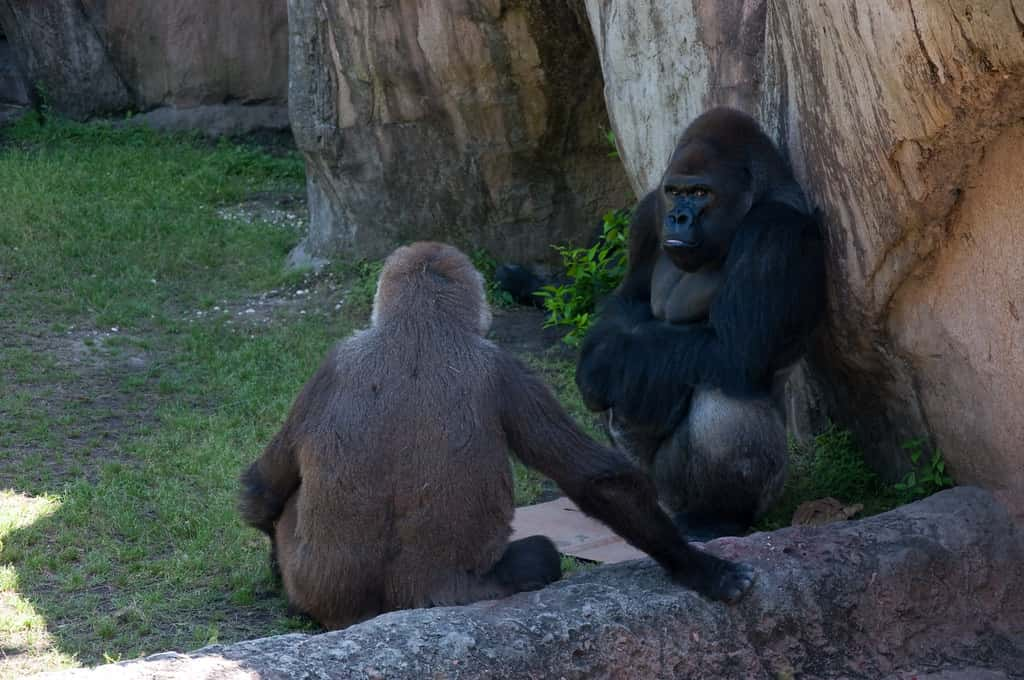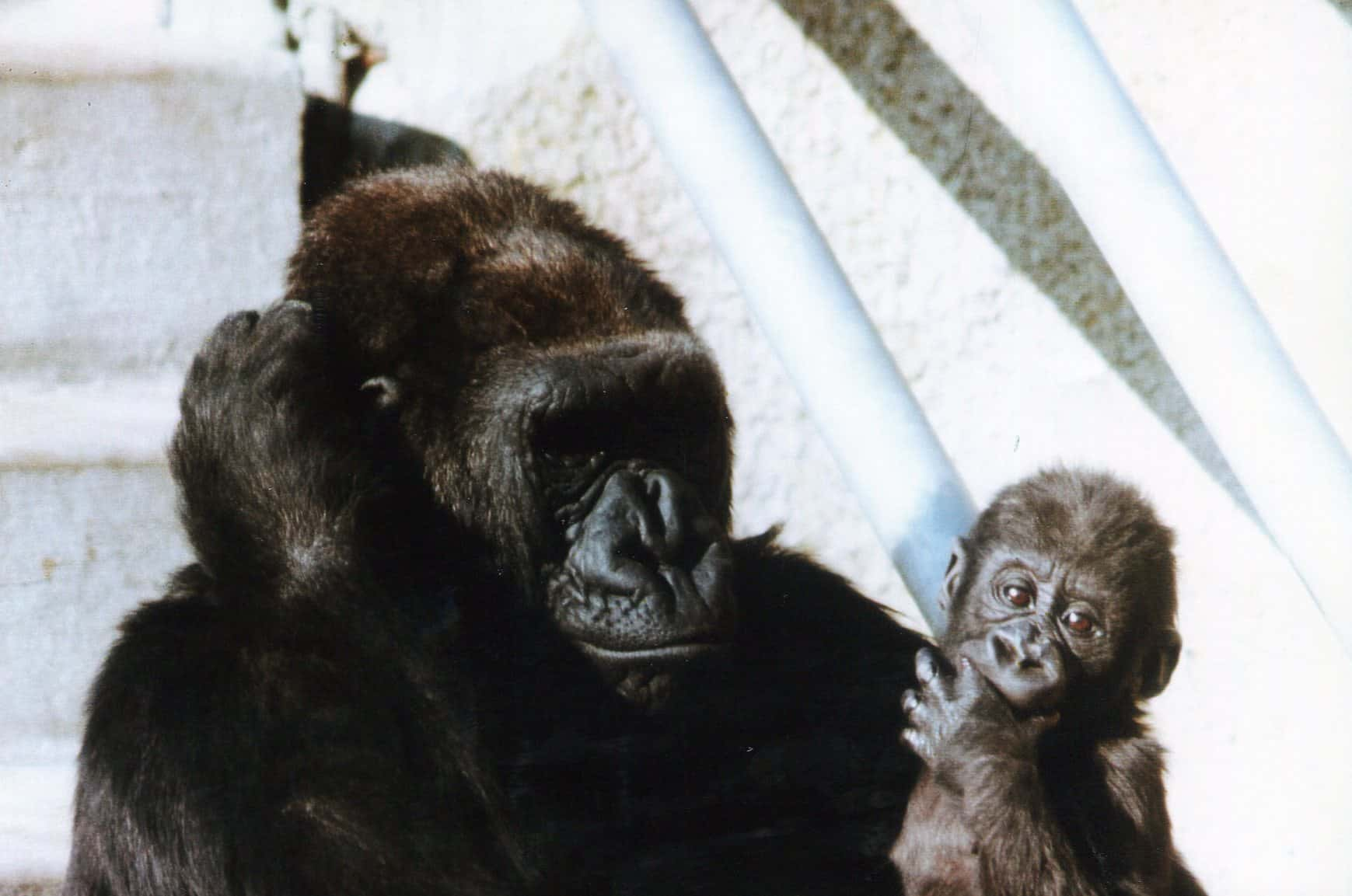“Uncontaminated by humans, [gorillas] are definitely closer to living in the now. Our problem is that we live in the past and we live in the future, but we very rarely dwell in the now. They are so much in harmony with nature, we surely could use them as a model".—Francine “Penny” Patterson
On June 21, 2018, the world lost another great mind when Koko the gorilla died in her sleep at home. Koko was 46 years old and well known and liked by everyone who encountered her. She won the hearts and minds of people everywhere through her love of cats and her ability to communicate using sign language. There really was no one quite like Koko, but I certainly hope there will be in the future. Koko has contributed to what we know about animals’ true capabilities and hopefully that knowledge will contribute to the education of many other apes to come. Over the past 46 years, Koko has gained many fans who love and respect her and her legacy will continue to benefit her species—and hopefully all of humanity—well after her passing. Here are 42 facts to remember Koko the amazing gorilla by and make you love her even more.
“Koko-love".—Koko the gorilla
1. Party for Koko
Koko might sound like an odd name for a gorilla, but that was just this lovable ape’s nickname. Her full name was “Hanabiko,” which is Japanese for “fireworks child". Koko was born in 1971 on the fourth of July, so her name references the events that occur each year on her birth date.

2. Are You Smarter Than an Ape?
Koko struck the world and changed it forever with her advanced use of sign language. She was taught a variation of American Sign Language by her caregivers and researchers that they called “Gorilla Sign Language". Koko could sign over 1,000 different words, which indicated advanced cognitive development for a non-human animal.
 Nature, A Conversation with Koko(1999), PBS
Nature, A Conversation with Koko(1999), PBS
3. See It to Believe It
Koko could reportedly reference objects through sign language that were not physically present with her. This may not sound very impressive, but it's actually a complex skill called displacement that is exceedingly rare in any animals other than humans.
 Nature, A Conversation with Koko(1999), PBS
Nature, A Conversation with Koko(1999), PBS
4. Who Am I?
You may have heard of the mirror self-recognition test in your first year psychology class because it is an important part of human children’s developmental cycle. The test determines whether the child has developed self-awareness and can usually be passed when a child is about 18 months old. Animals have also been put through this test, but only a couple have passed—including Koko. In the test, the animal is marked on their body in an area that can’t be seen without a mirror. The animal passes the test if they check out the mark on their own body with the understanding that the mirror is only a reflection of themselves, not another animal.
5. Yaaas, Queen!
“Queen” was one of the first words Koko signed to describe herself. According to Penny, her primary caregiver, Koko knew she was special because of all the attention she got from important people and the media.
 Nature, A Conversation with Koko(1999), PBS
Nature, A Conversation with Koko(1999), PBS
6. Koko’s Legacy
Koko’s legacy deserves to be honored and The Gorilla Foundation plans to do just that. They plan to continue their conservation of gorillas in Africa and their great ape sanctuary. They also plan on developing an app featuring Koko that will help both children and gorillas with sign language.
7. A Regular Shakespeare
Koko was known to invent new words in Gorilla Sign Language. For instance, when she wanted to communicate the word for “ring,” which she hadn’t learned, she signed the words for “bracelet” and “finger” to reference a bracelet that goes on your finger.
 Koko: The Gorilla Who Talks to People (2016 TV Movie), BBC
Koko: The Gorilla Who Talks to People (2016 TV Movie), BBC
8. What did the Gorilla say to the Researcher?
It’s hard to imagine an animal with a sense of humor, but Koko’s researchers say she definitely did. She could use her language to make fun of other people, suggesting she had a theory of other minds, another thing rarely seen outside of humanity. She was also able to discuss the language itself or, in other words, meta-language.
 Koko: The Gorilla Who Talks to People (2016 TV Movie), BBC
Koko: The Gorilla Who Talks to People (2016 TV Movie), BBC
9. Haters Gonna Hate
Not everyone loved Koko, she had her critics, too. Those skeptical of Koko’s abilities say that she only memorized words to please her owners and get rewards, not because she actually wanted to communicate or understood their meanings. These critics also point out the lack of scientific papers published about Koko, compared to the frequent pop articles that drew the public’s attention to her.
10. Cat-Lover
Koko LOVED babies and cats, so of course, she asked her caregivers for a pet kitten, just like any young girl would. The researchers complied and gave her a stuffed kitty for Christmas. Koko wouldn't let them insult her intelligence that easily, and she boycotted that stuffed cat and signed the word “sad” over and over until they gave her a real-life kitten. Eventually, Koko was allowed to pick her pet kitten out of a full litter and named her chosen cat “All Ball". The researchers say Koko cared for All Ball as if it was her own baby.
 Koko: The Gorilla Who Talks to People (2016 TV Movie), BBC
Koko: The Gorilla Who Talks to People (2016 TV Movie), BBC
11. Ready for Her Close-Up
Koko was on the front cover of National Geographic twice in her lifetime. The first time was a mirror selfie she had taken and the second was for a story about her and her pet cat. Koko really knew how to win the people’s hearts: selfies and kittens, obviously.
12. Funny Ape Meets Funny Man
Koko the gorilla got to meet Robin Williams the comedian. The two immediately became best buds; Williams tickled Koko and Koko tried on Williams’ glasses and the rest, as they say, is history.
 Koko: The Gorilla Who Talks to People (2016 TV Movie), BBC
Koko: The Gorilla Who Talks to People (2016 TV Movie), BBC
13. Save the Gorillas
The passing of Koko is especially tragic because her species, the western lowland gorilla, was classified as critically endangered as of 2016.
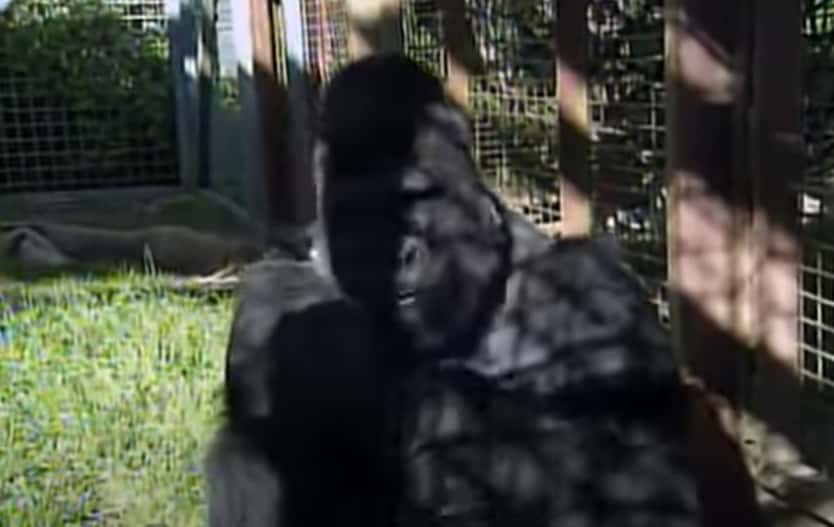 Nature, A Conversation with Koko(1999), PBS
Nature, A Conversation with Koko(1999), PBS
14. Good Move
Koko was born at the San Francisco Zoo and was moved to Stanford two years later where the not-for-profit organization called The Gorilla Foundation was established to protect and learn from gorillas.
 Nature, A Conversation with Koko(1999), PBS
Nature, A Conversation with Koko(1999), PBS
15. A Great Conversation Starter
Koko may not be able to communicate in any human languages besides sign language, but she can understand about 2,000 words in the English language. She can keep up fairly well in a conversation.
 Koko: The Gorilla Who Talks to People (2016 TV Movie), BBC
Koko: The Gorilla Who Talks to People (2016 TV Movie), BBC
16. Hungry, Hungry Koko
Three of Koko’s first words out of the over a thousand she now knows were “more,” “food,” and “drink". I guess know we know what is going on in our pet’s heads. Typical.
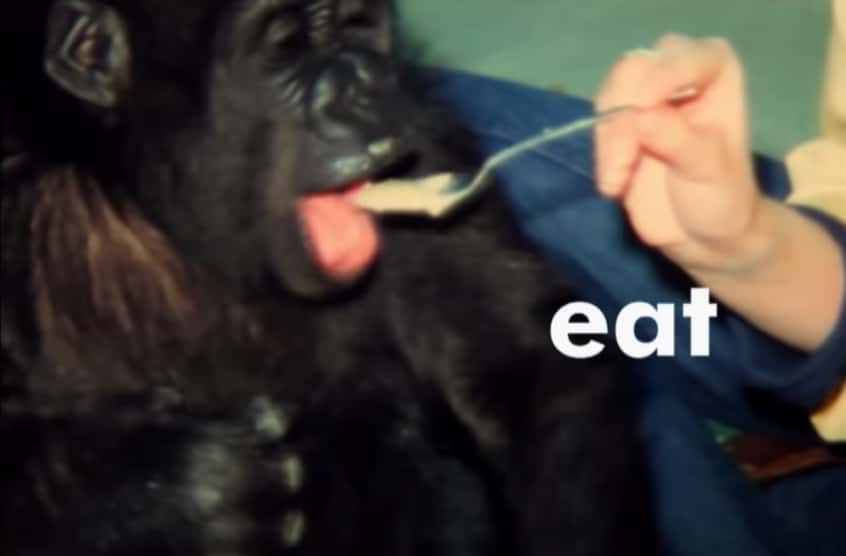 Koko: The Gorilla Who Talks to People (2016 TV Movie), BBC
Koko: The Gorilla Who Talks to People (2016 TV Movie), BBC
17. The Not so Terrible Twos
When compared with a human, Koko could communicate at about the level of a three-year-old. Most of her words were learned between the ages of two and five. She never really understood or used appropriate grammar or syntax, though.
18. The Circle of Life
It’s not only food that Koko expressed desire for through sign language. She also really wanted to give birth to her own gorilla babies. She also was able to express her own emotions, like that of sadness.
19. The Student Becomes the Teacher
Koko even had a best friend! She grew up with another ape named Michael who lived with her at The Gorilla Foundation, and he even knew some sign language too. Koko helped teach him how to sign, but he only ever learned about half of what Koko knew.
 Koko: The Gorilla Who Talks to People (2016 TV Movie), BBC
Koko: The Gorilla Who Talks to People (2016 TV Movie), BBC
20. Memory Palace
Koko’s gorilla friend Michael, through sign language, was able to communicate his first-hand account of the death of his mother, who was killed by poachers. Through moments like this, these gorillas have really altered what we know about animals’ abilities to grasp language, memories, and emotions.
21. Let Me Help You With That
On top of Robin Williams, Koko also got to meet Mr. Rogers, who she knew from watching Mister Rogers' Neighborhood. Of course, she recognized the man immediately and helped him take off his shoes because that’s what she watched him do on the TV so often.
22. Reading is Dreaming
Some of Koko’s favorite picture books were The Three Little Kittens and Puss ‘n’ Boots, so it makes sense that she wanted to be a proud cat mom so badly.
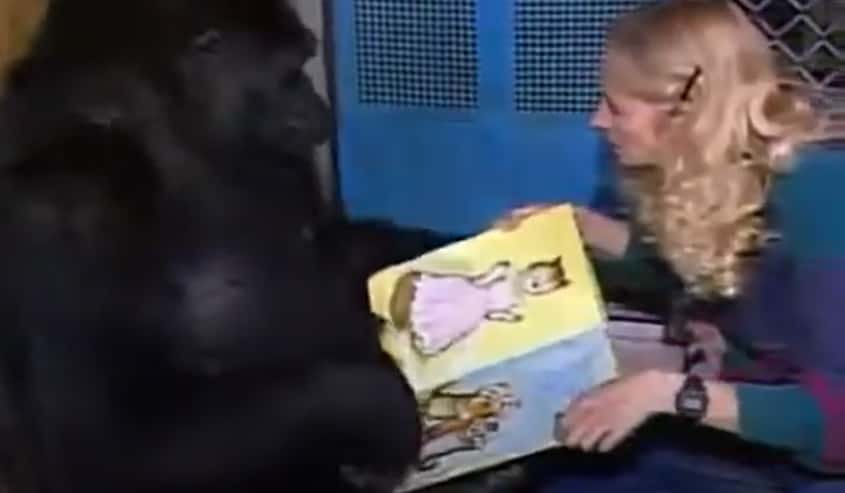 Nature, A Conversation with Koko(1999), PBS
Nature, A Conversation with Koko(1999), PBS
23. A Life-Long Bond
Francine Patterson, or “Penny,” took the one-year old Koko under her wing to teach her sign language as a part of her PhD thesis. The San Francisco Zoo agreed to lend the gorilla to her as long as she made a four-year long commitment. She ended up staying with Koko for the entirety of the gorilla’s life.
 Koko: The Gorilla Who Talks to People (2016 TV Movie), BBC
Koko: The Gorilla Who Talks to People (2016 TV Movie), BBC
24. Trust in Me
Interspecies communication, like that between Koko and her researchers, is used as a tool to create deep, trusting relationships between people and animals. It also allows the animals to communicate their wants and needs more easily to their human caretakers.
 Koko: The Gorilla Who Talks to People (2016 TV Movie), BBC
Koko: The Gorilla Who Talks to People (2016 TV Movie), BBC
25. Not Just Noise
Gorillas cannot speak the same way humans can, but they can make specific vocalizations like purrs, grunts, and hoots to express their emotions. Koko was also able to create new vocalizations unique to her, so the Gorilla Foundation is actively researching this phenomenon.
26. One of the Greats
The memory of Koko will be long-lasting in the world of research, and you can have a piece of her, too! Koko and Michael expressed themselves through the medium of painting during their lives and their best artworks are available for sale at the Gorilla Foundation website. They titled the artworks themselves based on their contents; some were abstract and others were representational of things found in their environment. They didn’t necessarily focus as hard or spend as much time creating their masterpieces as humans do, but they could acknowledge which paintings were no good by signing “toilet” at them.
27. Not the Only One
There have also been communication studies done with a chimpanzee named Washoe, an orangutan named Chantek, and a bonobo named Kanzi. Unlike Koko, however, there have not been many long-term studies with these animals. You could say apes that can communicate with humans are an endangered species in themselves, considering the lack of studies and Koko’s passing.
28. Grateful for Gorillas
The Gorilla Foundation says that the best way to help gorillas thrive is to learn more about them and remember that all gorillas have the capacity within them to learn like Michael and Koko. They are intelligent, emotional, and gentle creatures, not some King Kong-like caricature of apes.
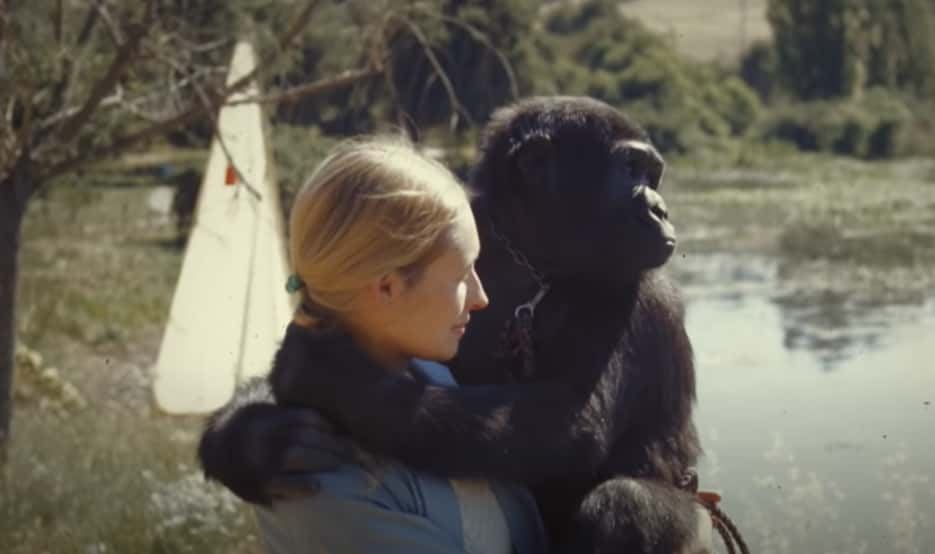 Koko: The Gorilla Who Talks to People (2016 TV Movie), BBC
Koko: The Gorilla Who Talks to People (2016 TV Movie), BBC
29. Make Love, Not Gorilla Orphans
The Gorilla Foundation isn’t just teaching gorillas how to communicate, they are also engaging people in gorilla conservation. They are teaching the world about Koko to inspire hunters not to illegally kill and sell apes in the wild and empathize with these beautiful creatures instead. They also take in orphaned apes and provide classroom lesson plans to teach about gorillas in schools.
30. Happy Birthday Dear Koko
For Koko’s birthdays, her supporters would send her presents and birthday cards that were mailed in as well as sent over the internet.
 Koko: The Gorilla Who Talks to People (2016 TV Movie), BBC
Koko: The Gorilla Who Talks to People (2016 TV Movie), BBC
31. A Growing Gorilla
In her life, Koko was fed seven pounds of food daily, spread across seven different meals. A lot of Koko’s caregivers’ days were spent preparing her food and feeding her. In the wild, gorillas spend 40-60% of their days finding, preparing, and eating food, and Koko’s caregivers wanted her life to be similar. They even made up interesting ways for Koko to “forage” for her food.
 Koko: The Gorilla Who Talks to People (2016 TV Movie), BBC
Koko: The Gorilla Who Talks to People (2016 TV Movie), BBC
32. Veggie Delight
Gorillas’ diets are plant-based and Koko’s was no exception. All of the gorillas at the Gorilla Foundation have diets matched to their own needs and the food is mostly organically grown.
33. A Rose by any Other Name Would Taste as Sweet
Koko’s favorite foods include stone fruits, berries, plantains and organically grown flowers like pansies, carnations, and roses. Koko’s friend from the foundation, Ndume the gorilla, didn’t like flowers at all, but he would eat their leaves and was a big fan of kale, quinoa and tempeh. He’d make a great hipster today.
34. Gorillas Just Wanna Have Fun
Grooming, climbing, problem solving, nesting, foraging—all a part of a gorilla’s balanced lifestyle. The Gorilla Foundation has a program to make sure these gorillas in captivity get the same pleasures in life as a gorilla in the wild, although, their enrichment program is a little more human than they might get otherwise. They are provided with cardboard boxes for nesting and lots of toys to play with, like books, flash cards, boxes, paints, and movies.
 Koko: The Gorilla Who Talks to People (2016 TV Movie), BBC
Koko: The Gorilla Who Talks to People (2016 TV Movie), BBC
35. Will Move for Food
Koko’s caregivers used behavioral conditioning to get her to perform necessary tasks like weighing her and transitioning her between areas. These tasks were still totally optional for Koko, but with a reward she almost always complied.
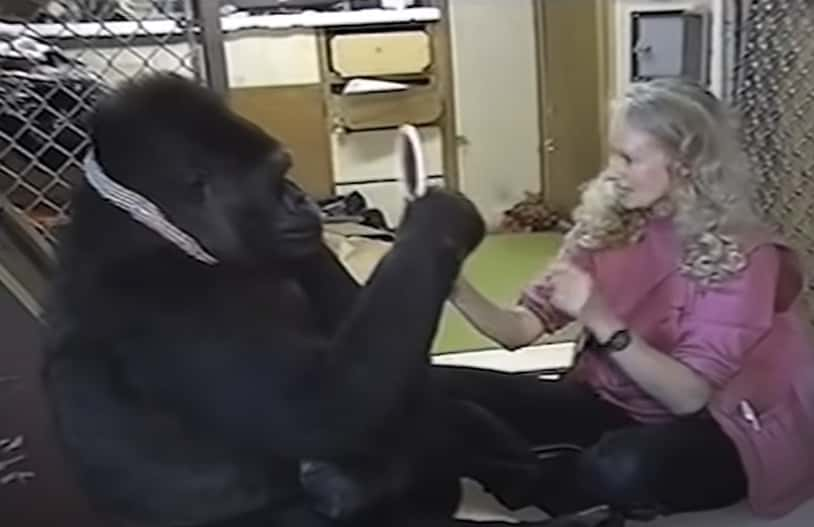 Nature, A Conversation with Koko(1999), PBS
Nature, A Conversation with Koko(1999), PBS
36. Long Distance Relationship
Koko had other family members before joining the Gorilla Foundation. Her mother and father’s names were “Jacqueline” and “Bwana,” respectively. She also had two brothers named “Sunshine” and “Mkubwa". Her more distant family of nieces and nephews are spread across different zoos in the US.
37. Film Buff
Koko was a bit of a cinephile. Her favorite movies included Free Willy, Doctor Doolittle, Maid in Manhattan, and Pretty Woman.
 Nature, A Conversation with Koko(1999), PBS
Nature, A Conversation with Koko(1999), PBS
38. Like Person, Like Ape
Gorillas are people, too. Or at least they cry like people do. Koko exhibited this behavior when watching a sad part in the movie Tea with Mussolini. When the boy says goodbye to his family, Koko would turn away and sign things like “mother,” “sad,” “trouble,” and “cry". Her eyes would get all watery proving, perhaps, that gorillas can express empathy like humans.
 Nature, A Conversation with Koko(1999), PBS
Nature, A Conversation with Koko(1999), PBS
39. Jack of All Trades
A reader, an artist, and also a musician. Koko learned how to play the recorder, which showed her wide mental capacity to learn new, intricate tasks and her ability to regulate her breathing in a complex manner. Before Koko, this was not thought to be in the range of a gorilla’s abilities.
40. A Sad Fall for All Ball
Koko understood the passing of her kitten All Ball. Many years after the loss of her kitten, which the researchers considered Koko’s own child, she would still sign the words “sad” and “cry” in mourning of her loss.
 Nature, A Conversation with Koko(1999), PBS
Nature, A Conversation with Koko(1999), PBS
41. Kids Will Be Kids
Koko was always a playful, curious, and active gorilla, even as a child. But as a kid she was also very insecure and carried a safety blanket with her whenever she experienced a new location.
42. Family Matters
Koko always wanted a baby gorilla to raise before her passing, and there was every indication that Koko would teach that child the sign language she knew. The Gorilla Foundation made it a goal of theirs to create a family between Koko, Ndume, and a baby gorilla, but it was never made a reality.
43. A Goodbye Kiss
Gorillas have been observed to bury dead animals when in captivity, so Koko likely always had an understanding of death. When shown a skeleton and asked whether it was alive or dead, Koko responded with the sign for “dead” and when asked where it would go now that it was dead, she signed “a comfortable hole” and gave a kiss goodbye. Now we all kiss Koko goodbye and hope that her own hole is a comfortable one.
 Nature, A Conversation with Koko(1999), PBS
Nature, A Conversation with Koko(1999), PBS
44. Cat Videos Are Forever
The loss of Koko’s friend Michael hit her very hard as well. She was so sad that she started eating less and stopped smiling. Not long after that was when Robin Williams visited her and made her smile, laugh, and play games again. Williams helped her healing process, so she was also understandably sad when she was told of his passing. Now, the rest of us must mourn Koko’s passing. Luckily, she has taught many of us how to laugh and smile and we will have her research and cat videos for years to come.
 Patch Adams (1998), Universal Pictures
Patch Adams (1998), Universal Pictures
Sources: 1, 2, 3, 4, 5, 6, 7, 8, 9, 10, 11, 12, 13, 14, 15, 16, 17, 18, 19, 20













